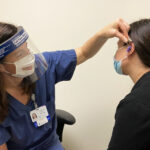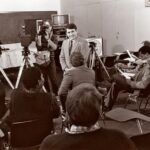Mass Eye and Ear researcher Zheng-Yi Chen, DPhil, is studying several approaches to reverse different forms of inherited deafness that he hopes can one day pave the way for treatments for many genetic and non-genetic forms of hearing loss.
Since the introduction of the cochlear implant more than 60 years ago, effective therapies for children who are born deaf have been lacking. A team of researchers at Mass Eye and Ear working in conjunction with colleagues at the Eye & ENT Hospital of Fudan University in Shanghai China – borne out of a Mass Eye and Ear training connection -– are hoping to change that longstanding problem.
In two recent studies, the researchers have revealed the safety and effectiveness of using a new gene therapy treatment for a specific form of inherited deafness called DFNB9. Their studies reported positive and life-altering results in 11 children in China treated in both trials combined.
These groundbreaking clinical trials can potentially revolutionize the field, opening new doors to using this approach to treat many forms of hearing loss, according to one of the lead investigators in the trial, Zheng-Yi Chen, DPhil, an associate scientist at Mass Eye and Ear’s Eaton-Peabody Laboratories.
“This gene therapy is really to show the proof of concept of this approach,” says, Chen. “It is a gateway for us to develop treatments for other types of hearing loss, whether it’s genetic, or non-genetic causes, like aging and noise-induced damage, which affect millions of people.”
Targeting deafness at the root genetic cause
Over 430 million people worldwide are affected by disabling hearing loss, and inherited deafness, caused by genetic mutations, makes up about 26 million of them.
For more than 20 years, Chen has devoted his lab to studying genetic-based approaches to treating these inherited forms of deafness. He has conducted countless preclinical studies in animal models to home in on approaches to target different genes. This type of work is especially complex because of the need to safely and successfully deliver a functioning gene or gene editing tools to correct the mutation within a specific segment of genome without affecting DNA elsewhere.
Nearly 15 years ago, Chen recruited a bright postdoctoral fellow to join in this work, Yilai Shu, MD, PhD. Once completing his research fellowship at Mass Eye and Ear, Shu returned to China with a goal to help translate these therapies into the clinic.
“I really appreciated the training at Mass Eye Ear and the work with Dr. Chen, that really has allowed me to carry out our dream to help patients,” says Shu. “His guidance has been very important, and with the hard work of our team in Shanghai, has contributed to what we’ve been able to achieve.”
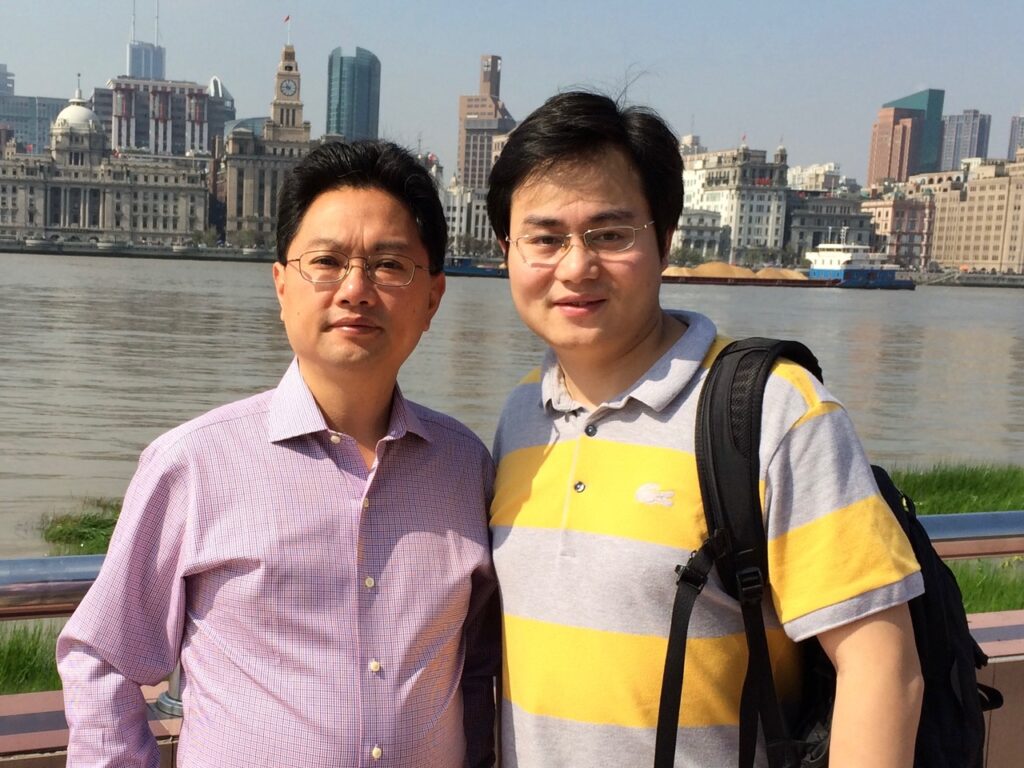
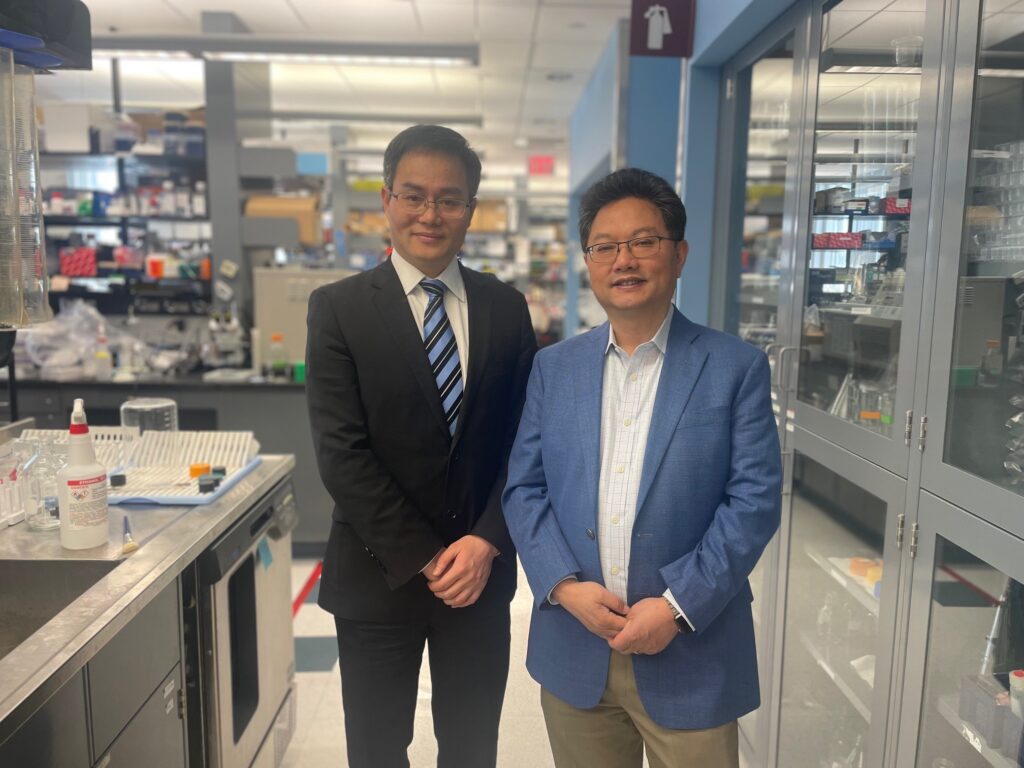
At Eye & ENT Institute of Fudan University, where Shu now serves as its deputy director, he had unique access to a large pool of patients with inherited deafness. This would not be possible in many countries, according to the researchers, where a few participants with a rare mutation might be in a recruitment pool. That led Chen and Shu to begin their trial in China, targeting DFNB9, which is caused by mutations in the OTOF gene. This mutation prevents the production of functioning otoferlin protein, which is necessary for the auditory and neural mechanisms underlying hearing.
In December of 2022, Shu became the first in the world to administer a gene therapy for this form of hearing loss, treating a young patient in one ear. The therapy, derived from Chen’s early experiments, was delivered in the form of an injection of the gene encased in a harmless Adeno-associated virus(AAV) vector. The vector is delivered through a minimally invasive surgical technique Shu developed to spare the delicate structures of the inner ear. Within only a few weeks, the child healed and could respond to sound. In this first phase of the trial, six children who were born totally deaf were treated in one ear, and according to results published in January 2024 in The Lancet, five of them regained their hearing and speech recognition within several weeks.
“When the parents realized that their kids have response to sound, they felt really, really excited and they cried,” recalls Shu. “And the first time they visited me in the clinic, and after assessment from the hearing test where I confirmed for them that it worked, they cried again. And my students, my team, they cried,” he says. “It was a really exciting moment.”
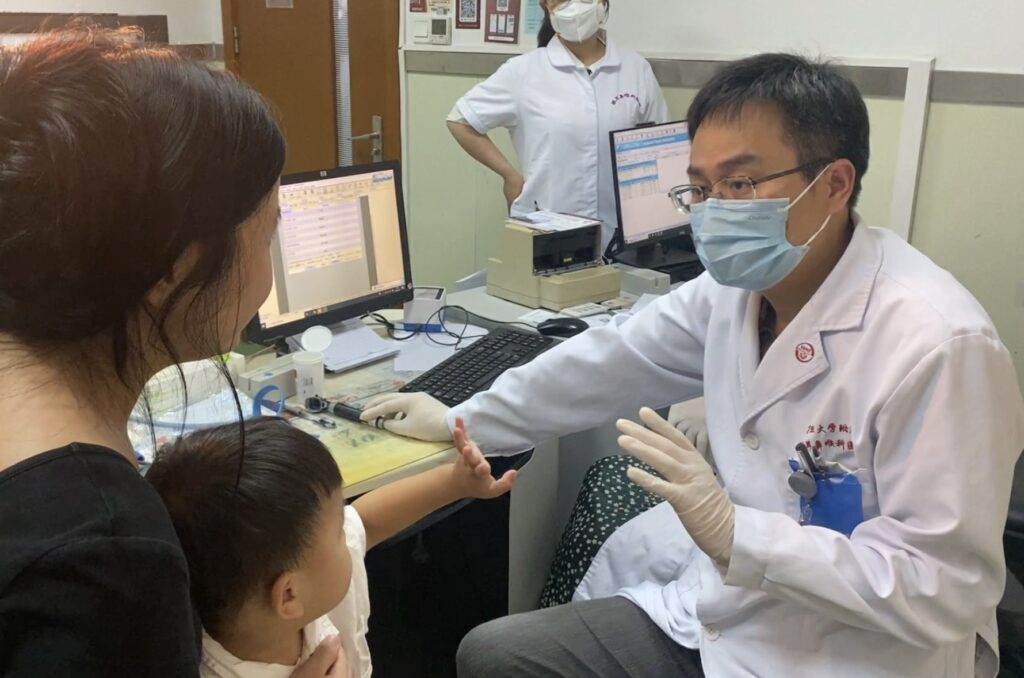
Soon after the completion of this first phase of the trial, the researchers moved onto testing the therapy in both ears, hypothesizing that it might lead to an even greater benefits in children.
“Treating both ears was always our goal because we hear sounds in three dimensions,” explains Chen. “Tasks like communication and driving require this ability, and we were hopeful to see whether the children had hearing gains beyond what the children treated with one ear experienced.”

Last month, this team was the first in the world to report results that demonstrated the restoration of hearing in both ears of five children with DFNB9. Not only did the children regain hearing, their study in Nature Medicine found that they experienced better speech perception compared to the first study and gained the ability to localize and determine where sound was coming from. Before-and-after videos filmed by their families demonstrated the dramatic results; two of the children were even filmed dancing to music, considered an especially complex listening task.
“They can hear all the nuances of the sound, different birds chirping, music, and other sounds we consider normal, that we don’t even pay attention – now they can suddenly experience it for themselves for the first time,” says Chen. “This has just been wonderful, one of the most exciting moments in my life.”
Expanding the international collaboration
The researchers feel their findings warrant additional trials that they hope to expand internationally, including to the United States. However, DFNB89 is only one disease that affects one gene, while there are at least 150 genes that cause deafness at birth. Typically to study another mutation in a gene therapy trial, researchers would have to start from the beginning by conducting preclinical animal studies showing safety and effectiveness before they can get federal approval to try to translate it to first-in-human clinical trials. That has spurred Chen to collaborate with Mass General Brigham’s Gene and Cell Therapy Institute with a goal of developing platforms and vectors with good manufacturing practice (GMP) standards. If such platforms got approved, this would enable the team to merely swap a new gene into the therapy, for testing.

Chen is also looking at ways to treat other types of deafness genes that require other approaches than the AAV-based gene therapy used in the DFNB89 trials. His team published a study this month describing the use of CRISPR Cas/9 genome editing to reverse deafness in mouse models with mutations in microRNA. The findings showed the approach was effective and safe, and next Chen is seeking to conduct Investigational New Drug (IND)-enabling studies in additional preclinical models in the hopes of moving this treatment approach into a first-in-human clinical trials. He is also actively studying Usher syndrome, a disease that causes deafness and blindness, with colleagues throughout Mass Eye and Ear including in the ophthalmology department.
Longer term, Chen believes similar approaches can be used to restore hearing loss caused by aging or other noise damage.
“Our ultimate goal really is to be able to develop treatments for as many patients as possible,” said Chen.
Read more on the June results from the trial treating children in both ears in the AFP, FOX News, The Harvard Gazette and Forbes. Results of the first trial in one ear, published in January, were featured in the Associated Press, Boston Globe, NPR, ABC News, Wired and Chronicle.


